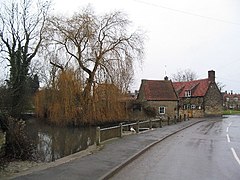Castle Bytham
| Castle Bytham | |
|---|---|
 Castle Bytham village pond |
|
| Castle Bytham shown within Lincolnshire | |
| Population | 768 (2011 census) |
| OS grid reference | SK989185 |
| • London | 90 mi (140 km) S |
| Civil parish |
|
| District | |
| Shire county | |
| Region | |
| Country | England |
| Sovereign state | United Kingdom |
| Post town | GRANTHAM |
| Postcode district | NG33 |
| Dialling code | 01780 |
| Police | Lincolnshire |
| Fire | Lincolnshire |
| Ambulance | East Midlands |
| EU Parliament | East Midlands |
| UK Parliament | |
Castle Bytham is a village and civil parish of around 300 houses in South Kesteven, Lincolnshire, England. The population was measured at 768 in 317 households at the 2011 census.
At one time the village was an important commercial centre for the surrounding agricultural communities, but it is now largely a dormitory, although a number of farming families remain with a much reduced workforce.
The name 'Bytham' is first recorded in 1067 (as a monastery that rapidly translated to Vaudey Abbey), and comes from the Old English word bythme meaning Valley bottom, broad valley. In the Domesday survey of 1086 the village was known as West Bytham as the castle had yet to be built. People have named the river that runs through the village the Tham or Am as a back-formation from the village name.
Morkery Wood housed a former bomb dump during the Second World War for the nearby airfields. In the early hours of 19 November 1942 Handley Page Halifax BB209 NP-G of 158 Sqn, from RAF Rufforth in North Yorkshire, crashed near Stocken Hall Farm (in the wood). It had been hit by flak south-east of Paris coming back from a raid on Turin, Italy. Half the aircrew were in the RCAF.
Overlooking the village is an 11th-century Norman castle mound. The site of the castle in Saxon times was owned by Morcar, also known as Morkere, who was the brother of Ealdgyth, wife of King Harold. His grandson married Lady Godiva. The castle, which gave its name to the village, was built soon after the Norman conquest and was given by the Conqueror to his half brother Odo, Bishop of Bayeux and Earl of Kent; it was later owned by William le Gros, 1st Earl of Albemarle, and was burnt in the 15th century during the Wars of the Roses.
...
Wikipedia

